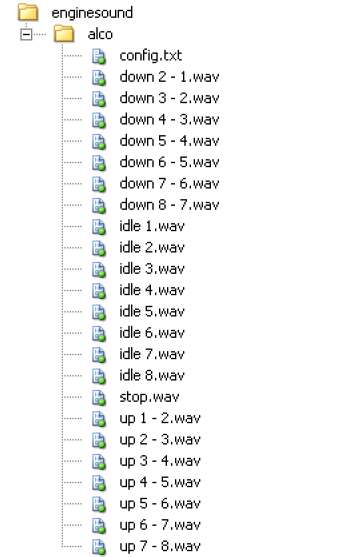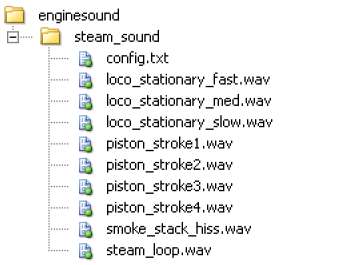CCG/Kind: EngineSound
Contents |
KIND: ENGINESOUND
These are the locomotive engine sounds, referenced by the enginesound tag in a traincar config.txt
With the inclusion of steam in TRS, we have added additional features for engine sound support.
For diesel and electric loco's the sound is generally as-per the UTC release (described here).
Steam sound requirements are described following the diesel sound section.
ENGINESOUND - DIESEL AND ELECTRIC
Diesel enginesound Directory Structure
Note: Diesel enginesound files (.wav) must be located in the same subfolder as the config.txt. You must ensure all custom engine sound files are named the same as those described in the example on the left.
Note: For general information on soundfiles and soundscripts for other uses see XXXXXXX
Config,txt (Diesel enginesound)
kuid <kuid:56113:1243>
trainz-build 2.5
category-class "ZS"
category-region "US"
category-era "1980s;1990s;2000s"
username "testEngineSound Diesel"
kind "enginesound"
description "Test Engine Sounds for diesel or electric."
thumbnails {
0{
image "thumb.jpg"
width 240
height 180
}
}
ENGINESOUND – STEAM
Custom steam sounds can be created for TRS. The following is a general break down of the required sounds needed and a brief description of how the sounds are used by TRS. These sound files described can be downloaded in zip format from this location: http://www.auran.com/TRS2004/downloads/contentcreation/TRS2004_Steam_Sound.zip
Steam sounds must be located in the default enginesound directory.
These files are the steam engine idling sounds played after the steam engine is stationary for 1, 2 and 3 minutes
· loco_stationary_fast.wav (after 1min)
· loco_stationary_med.wav (after 2mins)
· loco_stationary_slow.wav (after 3mins)
Note: Silent .wav files may be used for the above, for locomotives that do not use an air compressor, for example most UK locomotives.
Piston stoke sounds, played every 180 degrees revolution of the piston wheel played in sequence and repeated up to about 40 kph.
· piston_stroke1.wav
· piston_stroke2.wav
· piston_stroke3.wav
· piston_stroke4.wav
From 40 kph upwards, the following sound loop is cross-faded as the piston sounds die off. In TRS2004 the loop is pitched shifted (through code) relative to the locomotive's velocity. In TRS2006 the pitch shift is not currently functional.
· steam_loop.wav.
The general hiss from the smoke stack:
· smoke_stack_hiss.wav
Steam enginesound Directory Structure
IMPORTANT Note 1: You must ensure all custom sound files for steam trains are named the same as those described above.
IMPORTANT Note 2: The Steam loco driving bogey is connected to the piston and physics system by adding the following tag to the bogey's config.txt: direct-drive 1
(See PB_15_bogey2 Config.txt below)
This tag MUST be included for piston and steam sounds to work.
Config.txt
kuid <kuid:56113:1243>
trainz-build 2.5
category-class "ZS"
category-region "US"
category-era "1980s;1990s;2000s"
username "testEngineSound (Steam)"
kind "enginesound"
description "Test Steam Engine Sounds, based on the PB15."
thumbnails
{
0
{
image "thumb.jpg"
width 240
height 180
}
}
PB_15_bogey2 Config.txt
kind "bogey" kuid <kuid:44179:50003> animdist 3.816 category-class "AS" category-region "AU" category-era "1920s;1930s;1940s;1950s;1960s" direct-drive 1

